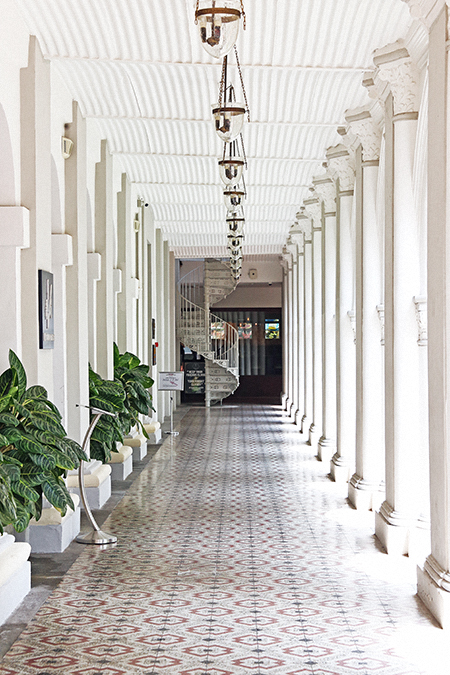10 THINGS TO SEE, DO, & VISIT IN SINGAPORE: A GUIDE BY A REAL-LIFE CRAZY RICH ASIAN
HAW PAR VILLA
If you are a Chinese child of a certain upbringing, your parents would have certainly brought you to Haw Par Villa to scare you onto the straight and narrow. What was intended by the Tiger Balm brothers to be the “Oriental Disneyland” has since been a cautionary tale of what happens to children who behave badly; what with its delightfully tacky 1,000 statues and 150 dioramas depicting scenes from Chinese mythology and Confucianism morality tales. Come for the folklore, stay for the gory scenes of what happens to sinners when they reach Chinese hell. In its heyday, the Tiger Balm Gardens – or Haw Par Villa as it is now known – was the recreational destination; today its a nostalgic trip for my generation as well as day-trips for schoolchildren who need some sense scared into them, the old-fashioned way. The graphic scenes are pushed into uncanny valley territory thanks to the crackling soundtrack of 1920’s swing and jazz music. My personal favourite song to admire the morbid scenes of sinners being punished is the cheery tune of “Let’s Misbehave”.
2.
PERANAKAN MUSEUM & NATIONAL MUSEUM OF SINGAPORE

CHINATOWN
There is a particular scene in the Crazy Rich Asians movie which, despite its departure from the source material, neatly tied up the plot while adding a visual richness. I’m talking about the scene where Eleanor Young meets Rachel Chu for a game of mahjong. The scene is filmed in Ann Siang Hill in Chinatown, a district full of character. The former immigrant enclave is a mosaic of new and old: where traditional apocatheries like Chop Wah On, historic temples such as Buddha Tooth Relic Temple jostle cheek-to-cheek with hip watering holes, boutiques, and juice bars. Start with a walk in the footsteps of Singapore’s early pioneers at the newly refurbished Chinatown Heritage Centre, then let your stomach lead you to the world’s cheapest Michelin-starred restaurant: Liao Fan Hong Kong Soya Sauce Chicken Rice & Noodle, where chef Chan Hon Meng’s iconic chicken rice dish will set you back all of S$2. When night falls, head to Duxton Hill to my favourite experimental cocktail bar Tippling Club for The Jolly Green Giant, a sweet blend of gin and peas.
LITTLE INDIA
Once a district of cattle herders and brick kilns, Little India is now a bohemian enclave of artists and one of Singapore’s most colourful districts. Gone are the Europeans who lived here in the 1840s for the racecourse; but the Hindu temples, goldsmiths, flower garland vendors, and saree shops remain. Singaporeans of all ethnicities love Mustafa, the 24-hour shopping centre institution where one can find the most obscure objects (I tracked down a subtitled copy of Bollywood classic Disco Dancer on DVD). The culinary offerings are delightful: from South Indian vegetarian food (Banana Leaf Apollo is a favourite) to roti prata (flat, thin pancakes) and teh tarik (watching the brewers ‘pull’ the hot milk tea is a show in itself). Then there‘s the district’s ridiculously photogenic buildings; a mix of Hindu and Chinese temples, mosques and churches. Unmissable (in more than one sense of the word) is Tan Teng Niah (above), the last surviving Chinese villa in Little India whose colourful facade is a photographer’s dream come true. Sri Veeramakaliamman Temple (left) is Singapore’s oldest Hindu temple. Dedicated to the goddess Kali, it was a place of refuge during WWII and miraculously escaped air raids and bombing, completely unscathed.
KAMPONG GLAM
The very name Kampong (village, provincial) Glam (glamourous) is an oxymoron, but the Malay enclave of Singapore really is a wonderfully eclectic contradiction. Kampong Glam, which was allocated to the Malay, Arab, and Bugis communities is now a trendy lifestyle scene set aside the country’s oldest urban quarter. Haji Lane is awash with indie boutiques, hip bars, and trendy cafes. The ever-changing lanscape of Haji Lane makes it difficult to recommend, but the Singapura Club (above) is a mainstay for eccentric drinks with a local flavour such as Milo Dinosaur cocktails. Arab Street and Bussorah Street are the places to go to for traditional wares such as Persian carpets and kebaya (traditional dress), as well as a haberdasher’s dream of fabrics, sequins, and embroidery (I recommend Royal Fabrics). Then there is the historical aspect of Kampong Glam the 2 icons of which are the Sultan Mosque and the Malay Heritage Centre on the grounds of the Istana (palace) to get a good sense of the rich history of Singapore’s Malay community. There are gastronomical offerings aplently, from local delicacies such as nasi padang (steamed rice served with various dishes. Hjh Maimunah is a local favourite) to Malay kuih (sweet, bite-sized desserts).
|
6. You may recognise Chijmes (simply pronounced Chimes. I don’t know what the point of the silent ‘J’ is) as the scene of Colin and Araminta’s wedding. This heritage building, built in 1852, was a Catholic convent and school. Even if you don’t plan to wed in the Gothic-style chapel (which is now a function hall) there is still a wealth to explore. Chijmes is now a complex of restaurants, cafes, and bars surrounding a lush green courtyard. I have always enjoyed the Pomelo & Tiger Prawn Salad and XO Braised Lobster Noodles (a classic childhood staple) at IndoChine. One of my favourite Japanese-western fusion chains, Tonkatsu by Ma Maison, has an outpost here – their pork cutlets are so wonderfully hearty and filling. Japanese cuisine seem to form the majority of the restaurants at Chijmes, but there are also other international offerings such as Carnivore Brazilian Churrascaria to New Zealand-inspired MOA Tiki Bar & Grill.
|
8.
SIP A SINGAPORE SLING
AND THROW BACK A TIGER BEER
9.
GARDENS BY THE BAY
10.
MARINA BAY SANDS
I hope you enjoyed my little guide to Singapore as well as a glimpse into the culture behind one of my favourite novels. x



























